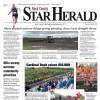
It’s Monday and I am thinking of all the pruning I got done last week. Now I’m looking at a blanket of the whitest and heaviest snow we have seen in awhile. But hey, the frost came out of the top layer of soil so this will be wonderful moisture to help replenish the deficit from last year.
So, we get a couple of days off but we do want to get the pruning done whenever we get the chance because just because we take a couple of days off, the calendar keeps moving.
Yearly I try to remind my gardening friends that cutting back the tall Carl Foerster ornamental grass should be the first pruning project to tackle. I got a lot of them cut last week and noticed that new growth was popping up already.
This is a cool season grass, so they are one of the first perennials to start growing. At this point, cut them back as close to the ground as possible, thereby eliminating all of the previous year’s growth, and they will look fresh from the start.
If you notice that the crown seems to be dead in the center with new growth around the edge, that’s an indication that it is time to divide the clump. Before you put all the effort into cutting it back, dig out the entire clump.
Use your spade to cut the root mass into four sections. Cut off the old growth on one section and plant it back into the hole where you dug it out. You can discard the other three divisions, plant them somewhere else, or bless a friend with them. Be prepared to add soil to the hole to account for the vacancy left from what you removed. Water the new transplant to settle the soil around the root mass. Easy … almost nothing to it!
This same thinning should be done to daylilies if those clumps have become so thick that they don’t seem to be blooming as plentifully as they did earlier. Ignoring the overcrowded condition situation will not correct the problem. People tend to procrastinate investing that hour of work and regret it for the rest of the season.
If you have a clump of rhubarb that you want to move or divide, now is when you want to get to it. Rhubarb can grow in the same location for years without complaining. Most often if begins to decline. The issue is inadequate sunlight or harvesting too late in the season, although it is pretty forgiving unless you continue late harvesting year after year.
The shade issue kind of sneaks up on a person. Trees don’t seem to grow all that fast and we tend to ignore them until a neighboring plant doesn’t seem to be blooming or growing as well as in previous seasons. In the case of rhubarb, it is easier to move the rhubarb to a site where it gets full sun than it is to move the tree.



